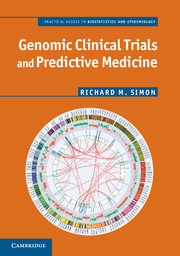Book contents
- Frontmatter
- Contents
- Acknowledgments
- Introduction
- 1 Clinical Trial Basics
- 2 Actionable Prognostic Biomarkers
- 3 Phase II Designs
- 4 Enrichment Designs
- 5 Including Both Test-Positive and Test-Negative Patients
- 6 Adaptive Threshold Design
- 7 Multiple Predictive Biomarkers
- 8 Prospective–Retrospective Design
- Appendix A Statistics Background
- Appendix B Prognostic Classifiers Based on High-Dimensional Data
- References
- Index
Appendix B - Prognostic Classifiers Based on High-Dimensional Data
Published online by Cambridge University Press: 05 February 2013
- Frontmatter
- Contents
- Acknowledgments
- Introduction
- 1 Clinical Trial Basics
- 2 Actionable Prognostic Biomarkers
- 3 Phase II Designs
- 4 Enrichment Designs
- 5 Including Both Test-Positive and Test-Negative Patients
- 6 Adaptive Threshold Design
- 7 Multiple Predictive Biomarkers
- 8 Prospective–Retrospective Design
- Appendix A Statistics Background
- Appendix B Prognostic Classifiers Based on High-Dimensional Data
- References
- Index
Summary
Good studies, whether prospective or retrospective, whether involving a single protein, genome-wide gene expression profiling, or DNA sequence analysis, require clear goals and careful planning if they are to be successful. Planning is driven by experimental objectives. Unfortunately, many prognostic factor studies and studies involving DNA microarray experiments do not have clear objectives and are not successful. Here, however, we will emphasize clear objectives and careful planning. We are not attempting to provide here a thorough description of the analysis of DNA microarray data. For that see texts such as that by Speed (2003) or Simon, Korn, McShane et al. (2004). One type of objective commonly encountered in DNA microarray experiments is identification of variables (e.g., genes) differentially expressed among predefined classes of samples. We will refer to this as the class comparison objective. A related but distinct objective that is more relevant to the topic of this book is development of a mathematical function that can accurately predict the prognosis of a patient based on measured variables. This will be referred to as class prediction or prognostic classification. Most research on prediction with high-dimensional data is focused on class prediction when there are two classes. We review some of the methodology available for this case and then discuss its extension to prognostic classification when the outcome is survival or some other right-censored time-to-event variable.
Before discussing class prediction, first let us distinguish it from class discovery. Class discovery is fundamentally different than class comparison or class prediction in that no classes are predefined. Usually class discovery is for the purpose of determining whether discrete subsets of a disease entity can be defined based on the gene expression profiles. This is different from determining whether the expression profiles correlate in some way with some already known diagnostic classification. Cluster analysis of one type or another is used for class discovery but is not effective for class prediction.
- Type
- Chapter
- Information
- Genomic Clinical Trials and Predictive Medicine , pp. 105 - 128Publisher: Cambridge University PressPrint publication year: 2013



